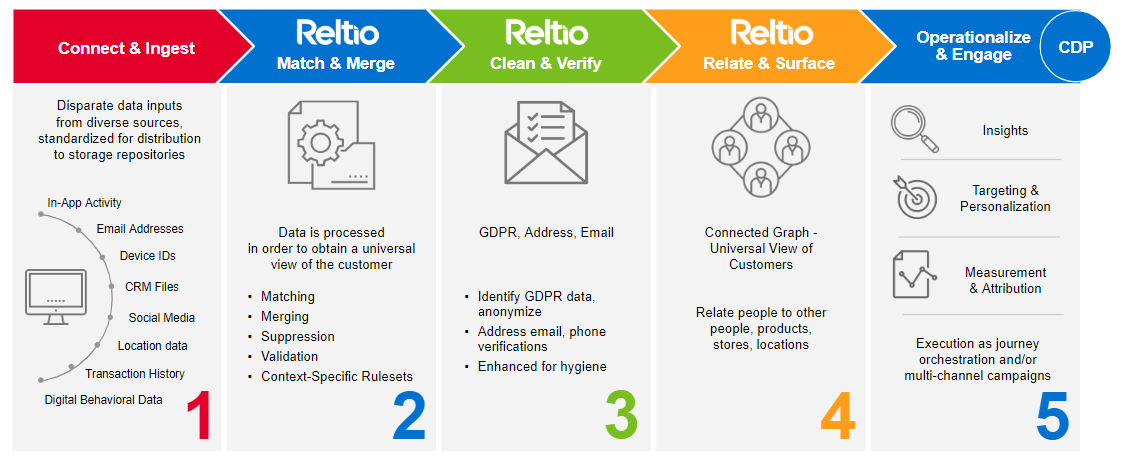Considering Customer Data Management? Taking the Right Approach in 2020

To compete today, it is increasingly vital for your organization to deliver rewarding, hyper-personalized experiences across all your interaction channels. To deliver these experiences, it all starts with customer data. How do you gain the connected, 360 degree visibility you need? Customer data platforms (CDPs), master data management (MDM) systems or something else? This blog examines the key requirements and technologies today’s digital enterprises require in order to establish modern data platforms.
Introduction: CDP or MDM?
Today, those enterprises with the best customer data are best equipped to succeed. Customer data is what fuels customer interactions. To win in your markets, your organization needs to meet the increasingly demanding expectations of consumers, who want rich, connected and personalized experiences across channels. At the same time, consumers expect that organizations will honor their communications and privacy preferences.
As teams look to pursue their customer data initiatives, they have traditionally focused on two key categories of offerings:
- Customer data platforms (CDPs). CDPs are applications that enable marketing teams to establish a unified customer database. Through these applications, teams can establish a standard, structured repository that enables customer data to be shared with other marketing systems.
- Master data management (MDM) systems. MDM systems enable teams to establish a single point of reference within the organization. MDM systems offer a varying set of capabilities, but at their core, they include mastered data, requirements around permissible values and analytics capabilities that can support decision making.
The New Requirements: Modern Data Platforms
The reality is that your enterprise needs a mix of the capabilities offered by traditional CDP and MDM systems. On their own, each of these technologies lack key capabilities. Typical MDM systems don’t provide insights into customer relationships and they lack information on omnichannel interactions, web clickstreams and historical transactions. On the other hand, most CDPs lack advanced data matching, merging, profiling, stewardship and governance capabilities.
Ultimately, your company needs all these capabilities—you need a modern data platform. It is only with a modern data platform that your teams can establish rich, connected customer data that the business requires. Today, this data is key to the success of virtually every marketing initiative and technology investment. Connected customer profiles can be a make-or-break factor in the success of customer relationship management, marketing automation, digital experience and a range of other applications.
Before we jump into the building blocks of a Connected Customer 360 profiles, here are some things to consider:
- Determine and document what is the desired customer experience that you want to deliver. Does it aligns with the customer expectations?
- Does your data strategy support that customer experience? Think of the holistic data strategy that includes master data, analytics, compliance, privacy & security, investments in AI/ML.
- Customer data is used and contributed to by marketing, sales, support, field service, order management, finance, compliance so customer data foundation must maintain and provision consistent data to the whole enterprise.
- Is your customer data supporting the customer journey across enterprise or creating a new silo of information?
To establish connected customer profiles, look for the following capabilities of a modern data platform:
1. Build a Single Customer View from all data
A comprehensive modern data platform must consolidate all information about customers, including people and organizations, in one place and make it accessible in real-time. Data from internal, external and third-party sources needs to be blended to create comprehensive and reliable profiles for individuals and accounts. This platform should also enable teams to ensure that customer information is continuously cleansed and optimized for ongoing insight and engagement.
2. Correlate Master, Interaction and Transaction Data
Your marketing teams want to understand customers’ needs as they evaluate, compare or buy products across your multichannel engagement models. To deliver omnichannel support for marketing, sales and service activities, your teams need to establish a uniform and complete understanding of customer behavior and preferences as well. This is where many MDM systems fall short. By blending omnichannel transaction and interaction information with master profiles, modern data platforms help teams understand customer product and channel preferences, and this information can be provisioned to analytics platforms to help users determine next-best actions for future engagement.
3. Uncover Relationships and Hierarchies
Today, it isn’t enough to bring data together from multiple sources. Teams also need to uncover relationships between consumers, products, organizations, stores, locations, family members, channels and transactions. By leveraging graph technology, a modern data platform enables teams to understand the many-to-many relationships between all data entities, which helps teams gain a deeper understanding of customers and perform more accurate segmentation. In a B2B customer scenario, you can model and manage custom hierarchies outside of formal legal structures and add business logic, such as sales territory alignments, to create visual, actionable views of your customers. With these capabilities, a modern data platform enables teams to group individuals into households based on their relationships and profile attributes.
4. Harness Analytics and Recommendations
With data blended in one place, marketing, e-commerce and support teams can get visibility into customer preferences, behaviors, product interests and channel choice. Organizations can understand customers’ needs and provide personalized experiences based on complete information. A modern data platform can deliver insights like churn propensity, lifetime value and abandonment rates to relevant teams in the context of their jobs and objectives. These platforms leverage machine learning and predictive analytics to suggest next-best actions, for example, helping identify up-sell and cross-sell opportunities.
5. Ensure Compliance
Modern data platforms should organically support the critical requirements of regulations like the General Data Protection Regulation (GDPR) and the California Consumer Privacy Act (CCPA). These platforms need to make it easy for staff to manage consumers’ profile information, lineage and succession as part of their day-to-day data management activities.
Modern data platforms should help teams capture and manage individual customer rights, including their right to be informed, access data, restrict processing and erase data. It is also increasingly critical that these platforms offer support for a range of consent types, such as informed consent, explicit consent and explicit parental consent. By leveraging graph technology, a modern data platform can help you better understand relationships among people, products, locations and consents. These platforms also deliver integrated workflow capabilities that help teams to support requests, such as “right to be forgotten” requests.
6. Establish Consistent Information with Personalized Views
It is vital to make all customer information available across the enterprise and to deliver data to business users via easy-to-use applications. This is where a modern data platform excels. Delivering consistent information across departments and channels, and throughout the consumer’s journey is essential for optimizing experiences. Consistency is possible only when there is a single source of truth for reliable customer data across the organization, and when all users work from the same source.
By offering role-based, contextual and consumer-grade applications to business users across marketing, finance, call centers, order management and field service, your teams can ensure that all users have access to reliable and consistent customer data. Industry-specific data-driven applications that bring together data and insights, relevant to the role and task at hand, improve operational efficiency as well as customer experiences. By offering intuitive, easy-to-use interfaces that are similar to consumer applications like LinkedIn and Facebook, modern data platforms enable teams to get started and be productive very quickly.
7. Foster Collaborative Curation of Data
For a large-scale enterprise, it’s critical that modern data platforms help teams to collaborate on ongoing data stewardship and on formulating customer engagement strategies. Modern data platforms must provide built-in annotating, tagging and voting capabilities, so every member can contribute, and continuously improve enterprise knowledge.
Structured collaboration, in the form of well-defined workflows, help teams manage the master data lifecycle and address change requests, delete requests and other processes. Workflow capabilities help enforce regulations and governance around data management. Platforms should also offer more ad-hoc forms of collaboration, for example, enabling users to add a comment anywhere on a profile and direct that comment to another user. This allows for faster and more interactive collaboration.
Conclusion
By implementing a modern data platform that addresses the capabilities above, teams can realize maximum value from their CDP and other martech investments. To deliver optimized results, platforms must:
- Enable teams to leverage data from diverse sources and standardize it for broad-based distribution.
- Support matching, merging and validation in order to establish a unified view of the customer.
- Clean and verify data in order to ensure data is accurate and compliant with relevant regulations and policies.
- Uncover relationships among people, products, stores, locations and more.
- Operationalize profiles so they can power optimized, real-time engagements.

Ultimately, it’s vital that your teams develop a holistic customer data management strategy while implementing modern data platforms. Investigate and document how industry leaders use customer data, who the users are and what the analytics, reporting and compliance requirements are. In addition, make sure that your data platform can grow as well as adapt to your changing business needs.